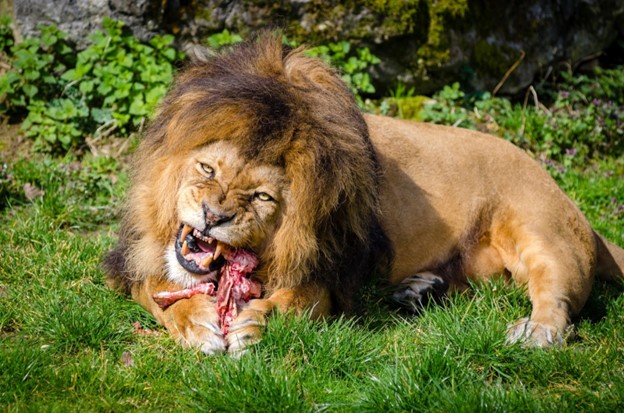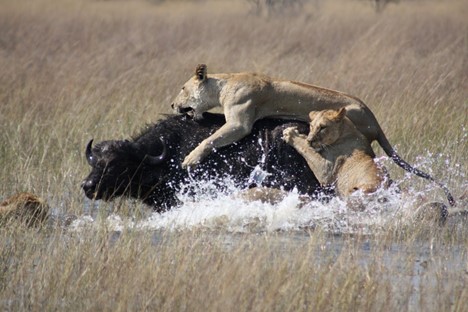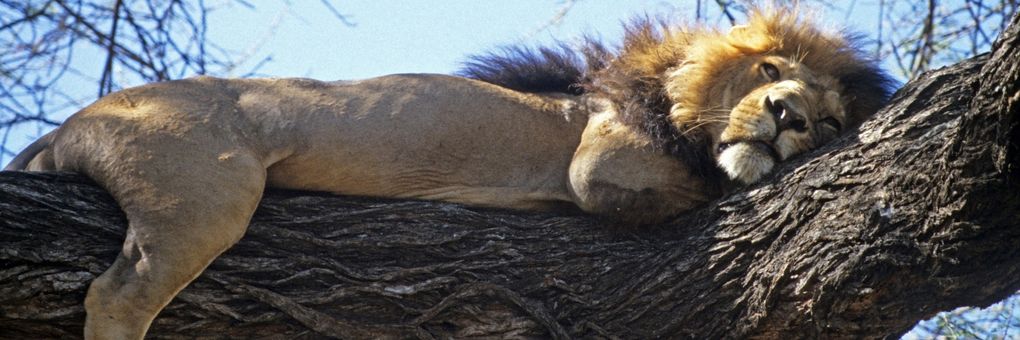Before the end of the Pleistocene Epoch 2.6 million years ago, lions roamed in North America, Africa, the Balkans, the Middle East, and India. Today it is estimated that only 20,000 lions remain in the wild. What do we know about these magnificent and formidable animals?
◊
While their killer instincts make them daunting foes in forests and grasslands alike, the authoritative dominance lions exert over their prey sometimes carries over within their own species as well. Attempts to join new social groups often end in mortal wounds. Adult males occasionally commit infanticide to assert their positioning within the heirarchy of their pride. Though lions can be enemies to themselves, it is the rise of poaching over the last few decades that has caused lion populations to plummet alarmingly.
For more on lions, check out the MagellanTV series The Lion Queen.
Lion Behavior Facts
It’s no secret that lions are fearsome predators. Among big cats, they are second in size only to tigers. They have no natural predators, which is largely attributable to their evolution and behavior patterns strongly influenced by how their bodies have adapted to their environment. Much of their behavior can be attributed to how their bodies have adapted to their environment. If you imagine a lion with an elephant’s blood dripping down its chin, it is clear that its spot at the top of the food chain is unthreatened and well-earned. When lions are not actively chasing down a meal, they like to sunbathe, aware that no one and nothing can harm them. Well, almost nothing.
The Jaws That Bite
In instances where a male lion is threatened by a rival trying to infiltrate his pride, the two can go head-to-head in a bloody clash of teeth and fur. Their mouths, which rip through an average of eight to nine kilograms (17.5–22 pounds) of meat a day, are framed by an impressive set of teeth. Their canines can grow to be seven to ten centimeters (2.75–3.9 inches) long and, when backed by the immense power of the lion’s jaw, can exert 690 pounds of pressure. Evolution has equipped lions with the teeth to tear apart its prey and a tongue covered with sharp spines called papillae that scrape meat off bones.

A lion ripping through meat with his teeth (Credit: Mathias Appel via Wikimedia Commons)
The Claws that Catch
Lions are members of the Felidae family of animals, colloquially known as cats. With a total of 36 subspecies, cats are native to all regions of the world save Australia and Antarctica. While domestic house cats have the same facial features, whiskers, large ears, and tails, the Felidae family has the largest range of body sizes among carnivores. If you have a house cat handy, looking at their paws will give you a good visualization of the retractable claws and rouge dewclaws on the front legs that can be used for gripping prey. Lions’ paws are almost six times the size your beloved tabby has, and they pack a harsh blow, known to cut down zebras, wildebeest, antelopes, and other lions with a single swat. Lions retract their claws to stealthily stalk animals, then extend them to rip through fur and flesh.
As adults, lions can weigh 265 to 400 lbs. But, amazingly, they can run as fast as 33 miles per hour.
Taking it Easy
From head to toe, lions’ bodies give them an advantage in their domain. For all the impressive statistics about their muscular builds and built-in weaponry, lions are lazy most of the time. They spend 16 to 20 hours a day sleeping, lounging, and relaxing. Lions have a small number of sweat glands, meaning they need to conserve energy to be able to attack when the moment is right. The inability to regulate their internal body temperatures dictates a lion’s behavior – from where they roam to when they bother to hunt. For that reason, these ambush predators prefer to hunt at night when they can thermoregulate.
Lion Habitat Facts
About 2,000 years ago, lions’ range included parts of Asia and Europe, and most of Africa. Today they can be found only in about six percent of the lands that were once their domain. Modern-day lions can be categorized into two groups: Africana and Asiatic. While the former is far more populous and widespread, the latter accounts for the big cats that roam India’s Gir National Park. While the answer to the question “where do lions live?” has changed drastically over the millennia, anyone who catches a glimpse of the beast would be hard pressed to ignore the encounter.

A lion blending in with tall grass in Kruger National Park, South Africa (Credit: Bjørn Christian Tørrissen via Wikimedia Commons)
Hard to Spot
While lions didn’t evolve to avoid the gaze of humans or our photographic tech, their sandy colored coats are well-adapted to fool other animals in grassland habitats. Lions are attracted to open woodlands, thick grasslands, and brushes where there are not too many obstacles to dodge in a hunt, but enough foliage to provide camouflage. These diverse ecosystems sustain a variety of plants that attract herbivores to the areas, which in turn are food for the lions.
Lions are often referred to by the moniker “King of the Jungle,” but they do not live in jungles. This misleading name is attributed to a Hindi word that has been lost in translation.
Lounging at the Pool
Predators are divided into two groups: ambush and cursorial. The latter group actively hunts prey, whereas ambush predators such as lions must be strategic about where they live to maximize opportunities for sudden attacks. The average lion pride will control an area between 8 and 150 square miles in size. While lions don’t particularly care where they kill their prey, areas concentrated around water holes and rivers are prime locations for picking off a few buffalo, kudu, or wildebeest, which are more water-dependent than other animals living in African savannas and grasslands. As lions, too, need water to regulate their body temperatures, spots close to water can be an appealing place for the cats to rest up and recuperate before taking their pick from a pack of animals in close proximity.
Up in the Trees
Despite their bulky size, lions lean into their inner cat and enjoy climbing trees. Lions will climb to escape a stampede of buffalo or incessant tsetse flies. Sometimes young cubs will claw their way up the bark of an umbrella acacia thorn tree just for fun. As they age and become heavier, it becomes harder for them to stick the landing coming down from a perch up high. The risk of dislocating a body part deters the behavior in many lions, but having the ability to look over their kingdom keeps some of them lingering in the limbs of sturdy savanna trees.
Lion Pride Facts
Retaining an air of exclusivity about their behaviors and movements, lions are the only animals to live in groups called prides. These social groups of male and female adults and cubs are fission-fusion social units, meaning that individuals form small communities that roam around a centralized area (though it is not uncommon for lions to separate for short periods to enjoy some alone time). Being part of a pride serves a number of purposes for lions. Lions not only feed in groups but also demonstrate protective behavior toward other members within their pride. Even when it is more efficient for lions to hunt alone, they will opt to hunt alongside their pride. While a single lion is a daunting sight on its own, a group of lions poses a threat few enemies would dare approach.

Lions attacking a water buffalo in Okavango Delta, Botswana (Credit: Corinata via Wikimedia Commons)
Fun and Games
Given that they are the most social of all felines, lion cubs have built-in playmates, courtesy of belonging to their pride. A key part of their social behavior is demonstrated by the play fights that lion cubs have with one another. Even as adults, lions bat at each other with their paws and roll around much in the same way that house cats or dogs might. Lions display affection by licking and nuzzling their heads up against one another. While female cubs tend to stick with the pride they are born into, males are pushed out of their home pride when they are three years old. At that point, finding a new pride is paramount in determining whether a lion will find new playmates or live out his life as a solo outcast.
A pride of lions can range in size from two to 40 members.
Hunting Party
Females only forage with members of their pride, while male lions tend to hunt alone. When lionesses hunt as a group, they secure food for themselves and their cubs. Cubs aren’t ready to hunt on their own until they are 11 months old, although most stay until they become sexually mature at the age of three or four years. Mothers teach their cubs the ropes of how to hunt, how to take advantage of their night vision, and how to use storms for stealth. During the hunt itself, lions will take on particular roles. Using center, left, and right wings, the lionesses will herd prey. A lot of targets use zig-zag methods to wear out their predators, but relying on their power in numbers, lions keep them in line. Once a kill is secured, there is a hierarchy of who gets to eat what, with cubs the lowest on the totem pole.

Two lions rubbing their heads together (Credit: Andrea Brataas via Unsplash)
Maternal Instinct
Most female lions give birth for the first time when they are four years old. They tend to have litters of two or three cubs at a time and are capable of having up to six litters in a lifetime. To give birth and raise her cubs for the first six weeks of their lives, a lioness will temporarily separate from her pack. She will opt for a cave or well-camouflaged bush to have her cubs out of sight from any opportunistic predators. Once a mother and her offspring rejoin a pride, the lionesses share responsibility for caring for the cubs. Any lactating lions will nurse any cubs, whether or not they are hers. Mortality rates for cubs under two years old can be up to 86 percent due to starvation, abandonment, and attacks by hyenas and leopards – so the effort to rear a baby lion from infancy to maturity is no small task.
Lion Conservation Status
Lions are at the top of their food chain, but in the 21st century, threats to flora and fauna extend far beyond natural predators. Habitat degradation, decreasing supplies of prey, proximity to humans, and hunting practices have seen the worldwide population of lions dwindle 43 percent over the last 20 years and 90 percent over the last century. The International Union for Conservation of Nature has listed lions as a vulnerable species, verging on endangered status.
Threats in the Wild
Deforestation practices across Africa and Asia are transforming some parts of lion habitats into unrecognizable landscapes, clearing away grasslands and forest that once housed entire ecosystems. In addition, poaching and killing lions to use their body parts for aesthetic or spiritual purposes is an ongoing threat to the species. But with ecotourism accounting for a good part of economic activity across Africa, lion hunting is a highly profitable industry that some resist banning. As a work-around for the ethical conundrum of permitting the killing of such a majestic animal for sport, some conservationists are breeding lions in captivity for the designated purpose of fulfilling this demand.
Efforts to Discourage Poaching
African lions are the only big cat of the genus Panthera that the Convention on International Trade in Endangered Species of Wild Fauna and Flora (CITES) decided could be legally traded in international commercial markets. The U.S. has suspended trophy imports of lion carcasses and bones across its border, but worldwide trade continues due to demand in other countries.
While efforts to discourage poaching have been ongoing for generations in all parts of the world, concerns around the future of lions are uncertain, as the demand for their bodies still exists. It would take a cultural overhaul in many different sections of the world to curtail the demand for dead lions.
An Enduring Legacy and an Endangered Future
The facts speak for themselves: Lions are mighty beasts with complex behaviors and physiologies. They create communities, strategize hunts, and play with one another in ways that so closely resemble human behavior it can be easy to overlook the teeth and claws, and just see big cats lounging in the sun.
A love of lions can come from seeing them in a zoo, getting up close on a safari, reading about them, or feeling their power through poetry. A survey of lions’ majesty and the awesome status they hold in human consciousness makes it hard to believe that a creature we revere so highly could so easily vanish.
Ω
Daisy Dow is a contributing writer for MagellanTV. She also writes for Local Life magazine. Originally from Georgia, she studied philosophy and studio art in college. She now works in Chicago as a local media specialist.
Title Image: Lion on tree in Lake Manyara National Park, Tanzania (Credit: Salix Oculus via Wikimedia Commons)

